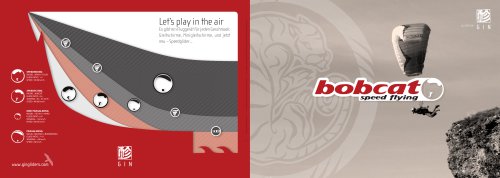
Katalogauszüge

Yeti Cross Rescue Parachute Manual Please read this manual prior to installing the GIN rescue parachute into your harness
Katalog auf Seite 1 öffnen
Thank for choosing Gin Gliders. We are confident you’ll enjoy many rewarding experiences in the air with your GIN rescue. This manual contains important safety, performance and maintenance information. Read it before your first flight, keep it for reference, and please pass it on to the new owner if you ever re-sell your rescue. Any updates to this manual, or relevant safety information, will be published on our website: www.gingliders.com. You can also register for e-mail updates via our website. Happy flying and safe landings, GIN team SAFETY NOTICE Like any extreme sport, paragliding...
Katalog auf Seite 2 öffnen
Introducing the Yeti Cross Purpose The Yeti Cross was developed to be used as a manually released parachute for paraglider pilots in an emergency situation while flying. Conditions of use Maximum speed for usage: 32 m/s (115 km/h) Repacking interval: 6 months, the rescue parachute should be repacked and recorded in the “Re-packing History” section of this book. Inspection interval: 6 months, each time the rescue is repacked it should be inspected for damage, the effect of water, sand, salt or other environmental influences may reduce the repack / inspection interval. Replace: 10 years, it...
Katalog auf Seite 3 öffnen
GIN rescue parachutes are inspected and packed at the factory. It is recommended that the reserve is repacked by a suitably qualified and experienced paragliding professional or parachute rigger prior to installation into your harness. The efficacy of the rescue, and your life, depend on the correct packing procedure. If in any doubt whatsoever, please seek professional advice from your instructor, GIN dealer or importer. Airing Before packing, the canopy should be aired. Ideally, the canopy should be hung by its apex from the ceiling for between 6 and 24 hours in a cool, dry room....
Katalog auf Seite 4 öffnen
Packing Instructions Line check 1) Stretch the rescue out to its full length. 2) Anchor the riser connection to keep lines tight. 3) Check the suspension lines for tangles by the “4 lines check” method: - All lines should be located inside the first 2 and last 2 lines as illustrated. APEX / CENTER LINE
Katalog auf Seite 5 öffnen
Packing Instructions... Folding the panels 1) Separate lines as shown: - Make sure 1 is on TOP, 11 is on BOTTOM and the Center Line MIDDLE 2) Fold in half with all of the panels to the LEFT NOTE: Use the Center Label as a reference point.
Katalog auf Seite 6 öffnen
Packing Instructions... Dividing the panels Begin to fold all of the panels to the RIGHT. There are 2 corner sections on each side that should be folded as shown below: IMPORTANT: The 2 corner sections on each side should be folded as shown.
Katalog auf Seite 7 öffnen
Packing Instructions... Once you reach the TOP pannel, place weights on the RIGHT side to keep the folds clean. Fold the rescue in half again, this time onto the RIGHT side. Carefully fold all of the LEFT panels. IMPORTANT: Make sure that all the skirts are even and all the lines are tight together.
Katalog auf Seite 8 öffnen
Packing Instructions... After you have neatly folded both sides of the rescue, check that the panels are clean and the lines are free of tangles IMPORTANT: After folding all the panels, check again that the center seams and the inside of the panels are even and lie in the same direction.
Katalog auf Seite 9 öffnen
Packing Instructions... Inner bag folding 1) Fold the bottom corners of the rescue in to the mid-line. 2) Next fold the rescue into 1/4 by folding the left and right edge in to the mid-line. 1
Katalog auf Seite 10 öffnen
Packing Instructions... 3) Fold the rescue in half. 1 4) Carefully fold the rescue onto itself as shown. 3
Katalog auf Seite 11 öffnen
Packing Instructions... Fold the rescue over the top of the suspension lines. Fold the top to make clean. Fold the rescue so that the suspension lines are in the middle, be sure to follow this pattern.
Katalog auf Seite 12 öffnen
Packing Instructions... Place the folded rescue into the inner bag. Fold 60cm of line under the rescue. Fold the para-cord into symmetrical bundles the approximate width of the bag. Secure the suspension line using the middle elastic band. Use elastic bands to hold the loops and neatly stack the bundles at the bottom of the bag.
Katalog auf Seite 13 öffnen
Packing Instructions... Close the bottom flap in the order shown. (1) Center There should be around 40cm of suspension line remaining to connect with the harness.
Katalog auf Seite 14 öffnen
Installation into the harness The Yeti Cross is compatible with GIN harnesses. It may also be compatible with most other manufacturer’s harnesses, but there is no guarantee of this and you should check with your instructor or dealer. Outer container attachment The Yeti Cross can be attached to harnesses which do not have a built-in rescue container, like the speed glider harnesses. Use of a rescue on these harnesses requires an outer container bag. You must follow the harness and outer container bag instructions for proper attachment. If in doubt, consult with a professional. Attaching the...
Katalog auf Seite 15 öffnen
Installation into the harness... Attaching the deployment handle Most harnesses come with their own deployment handle. This handle and its strap must be connected to the deployment bag of the parachute. In particular, check the length of the strap connecting the rescue deployment handle to the rescue inner container. It should be long enough that the reserve can be extracted without the danger of the pins not being pulled before the strap tightens on the reserve, but not so long that there is excessive slack that extends the movement required for deployment. Preflight checks For maximum...
Katalog auf Seite 16 öffnen
Deployment procedure Rescue deployment It is vital to periodically feel the position of the rescue handle in normal flight, so that the action of reaching for the rescue is instinctive in an emergency. In the event of an emergency, the pilot must quickly evaluate his or her height and the seriousness of the incident. On that basis, an instantaneous decision to deploy the rescue or not must be taken. Deploying the rescue when the glider is recoverable may increase the danger of injury. If you have sufficient height and the glider is in a flat spin, it is preferable to first try to stop the...
Katalog auf Seite 17 öffnenAlle Kataloge und technischen Broschüren von GIN Gliders
-
pg-explorer-manual-de
54 Seiten
-
Nano
2 Seiten
-
YAK
2 Seiten
-
Bobcat
4 Seiten
-
2024 CATALOGUE
35 Seiten
-
2022 CATALOGUE
37 Seiten
-
2021 CATALOGUE
37 Seiten
-
hs-gingo-airlite-4-manual-en
29 Seiten
-
gr-rucksacks-guide
3 Seiten
-
Catalog Gin
37 Seiten
-
Bolero_5
35 Seiten













